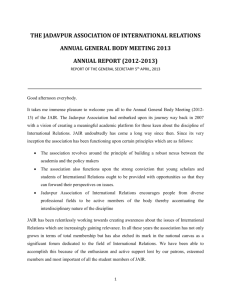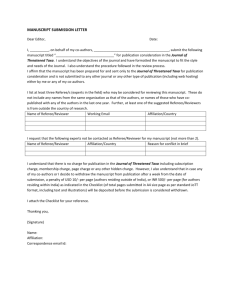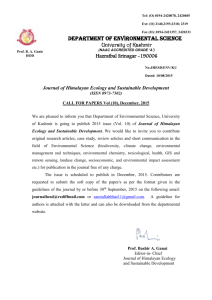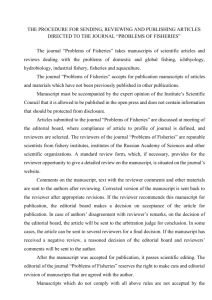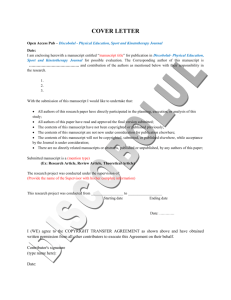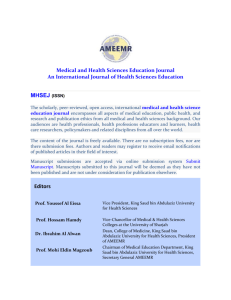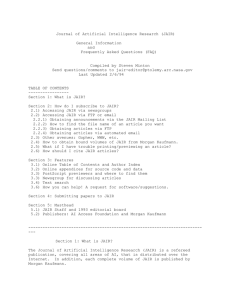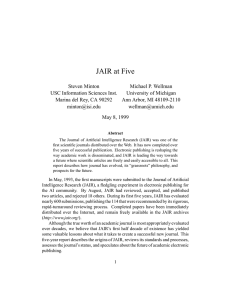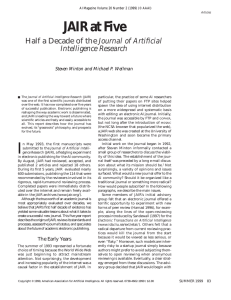AUTHOR-INFORMATION-GUIDE-FOR-PUBLICATION-IN-THE
advertisement
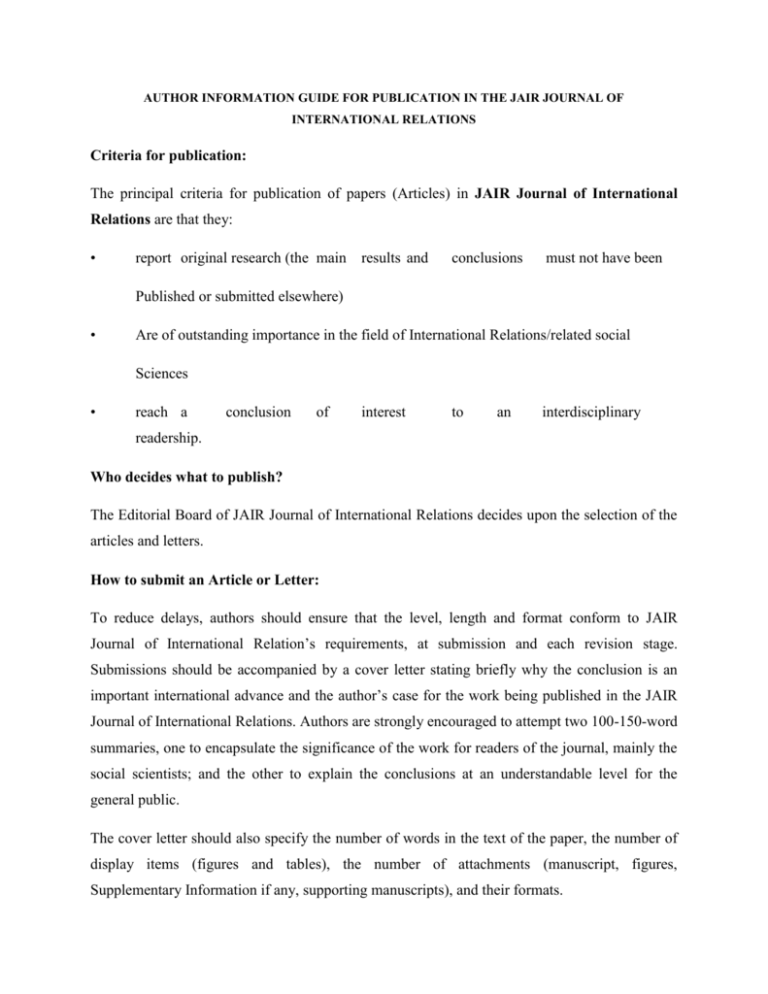
AUTHOR INFORMATION GUIDE FOR PUBLICATION IN THE JAIR JOURNAL OF INTERNATIONAL RELATIONS Criteria for publication: The principal criteria for publication of papers (Articles) in JAIR Journal of International Relations are that they: • report original research (the main results and conclusions must not have been Published or submitted elsewhere) • Are of outstanding importance in the field of International Relations/related social Sciences • reach a conclusion of interest to an interdisciplinary readership. Who decides what to publish? The Editorial Board of JAIR Journal of International Relations decides upon the selection of the articles and letters. How to submit an Article or Letter: To reduce delays, authors should ensure that the level, length and format conform to JAIR Journal of International Relation’s requirements, at submission and each revision stage. Submissions should be accompanied by a cover letter stating briefly why the conclusion is an important international advance and the author’s case for the work being published in the JAIR Journal of International Relations. Authors are strongly encouraged to attempt two 100-150-word summaries, one to encapsulate the significance of the work for readers of the journal, mainly the social scientists; and the other to explain the conclusions at an understandable level for the general public. The cover letter should also specify the number of words in the text of the paper, the number of display items (figures and tables), the number of attachments (manuscript, figures, Supplementary Information if any, supporting manuscripts), and their formats. What happens to a submitted Article? The first stage for a newly submitted Article is that the editorial staff considers whether to send it for peer-review. On submission, the manuscript is assigned to an editor covering the subject area, who seeks informal advice from academic advisors and editorial colleagues, and who makes this initial decision. The preliminary judgment is not a reflection on the qualitative validity of the work described, or on its importance to people in the same field. Once the decision has been made to peer-review the paper, the choice of referees is made by the editor who has been assigned the manuscript. Most papers are sent to two or three referees, but some are sent to more or, occasionally, just to one. Format of Writing an Article: Articles are original reports whose conclusions represent a substantial advance in understanding of an important problem and have immediate, far-reaching implications. They do not normally exceed 8 pages and have no more than 50 references. (One page of undiluted text is about 1,300 words.) Articles have a summary, separate from the main text, of up to 150 words, which does not have references, and does not contain numbers, abbreviations, acronyms or measurements unless essential. It is aimed at readers outside the discipline. This summary contains a paragraph (2-3 sentences) of basic-level introduction to the field; a brief account of the background and rationale of the work; a statement of the main conclusions (introduced by the phrase 'Here we show' or its equivalent); and finally, 2-3 sentences putting the main findings into general context so it is clear how the results described in the paper have moved the field forwards. Articles are typically 5,000-8000 words of text. The text may contain a few short subheadings (not more than six in total) of no more than 40 characters each (less than one line of text in length). Articles typically may have not more than 5 or 6 display items (figures or tables). The rest of the text is typically about 1,500 words long. Any discussion at the end of the text should be as succinct as possible, not repeating previous summary/introduction material, to briefly convey the general relevance of the work. Word counts refer to the text of the paper. References, title, author list and acknowledgements do not have to be included in total word counts. STANDARD FORMAT FOR WRITING JAIR PAPERS/ARTICLES 1. Use Microsoft word document for writing the paper. 2. Use 12 pt BOLD (ALL CAPS) for the TITLE OF THE PAPER. 3. Use 12 pt. Bold for sub headings. 4. Use 12pt. normal for the main text. 5. Use Times New Roman for all. 6. Use citations as indicated below: For Books One author 1. Michael Pollan, The Omnivore’s Dilemma: A Natural History of Four Meals (New York: Penguin, 2006), pp. 99–100. Two or more authors 2. Geoffrey C. Ward and Ken Burns, The War: An Intimate History, 1941–1945 (New York: Knopf, 2007), p.52. Journal article Article in a print journal In a note, list the specific page numbers consulted, if any. In the bibliography, list the page range for the whole article. Joshua I. Weinstein, “The Market in Plato’s Republic,” Classical Philology, No.104 (2009), p.440. Using Item in a commercial database: For items retrieved from a commercial database, add the name of the database and an accession number following the facts of publication. In this example, the dissertation cited above is shown as it would be cited if it were retrieved from ProQuest’s database for dissertations and theses. Choi, Mihwa. “Contesting Imaginaries in Death Rituals during the Northern Song Dynasty.” PhD diss., University of Chicago, 2008. ProQuest (AAT 3300426). Contributors must provide their institutional affiliations and complete postal and-mail addresses with their articles. Whenever possible, please send us the URL of your institutional website. Articles should ideally be 5,000 to 8,000 words in length. All articles must be accompanied by an abstract of 100–150 words. Please include a list of seven (7) keywords. Use single quotes throughout. Double quotes marks are used only within single quotes, to indicate a quotation within a quotation. Spellings of words in quotations should not be changed. Quotations of 45 words or more should be separated from the text and indented with one space with a line space above and below. SCHOLARS ARE ENCOURAGED TO SEND THEIR ORIGINAL ARTICLES FOR THE JOURNAL IN THE PRESCRIBED FORMAT. SCHOLARS MAY SEND THEIR ARTICLES AT: journal@jair.net.in also, send your full article neatly printed in A-4 size paper along with a CD containing the article to: Dr. Imankalyan Lahiri, General Secretary, JAIR 29, Brahmapur, Govt. Colony, Bansdroni, Kolkata 700070 West Bengal, India JAIR reserves the publication rights of the article and intimation will be given only to the authors whose article will be selected for publication.
